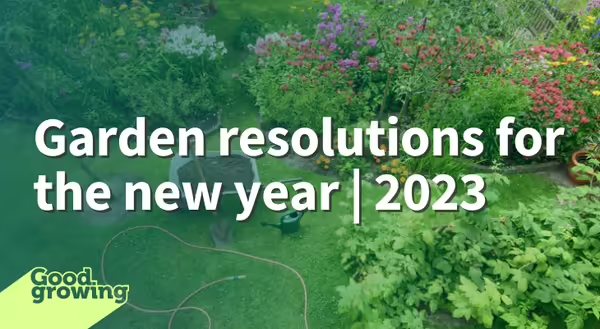
As we approach the new year, we often find ourselves reflecting on the events of the last year. The new year also provides us an opportunity to start anew, often in the form of New Year’s resolutions. Whether it be starting a vegetable garden, growing more flowers for pollinators, composting, mowing less, or scouting your garden, consider making a resolution/goal or two for the garden. Below are some of our gardening resolutions for 2023 (you can help keep us accountable).
Chris:
Timeliness – Every year, I get sucked into the tractor beam of procrastination. When you garden for a living, gardening at home often takes a backseat. My articles, classes, and videos to plant cool season crops in August takes priority over me actually practicing what I preach and getting seeds or plants in the ground at the opportune time. Anymore I live and die by my work calendar, so I will put actual appointments on my work calendar to go home and start seeds or get transplants planted. I’m tired of planning a garden to wind up not having enough time to garden.
Get to Know Sedges – Sedges are grass-like plants that are taking the horticulture world by storm. Many of the sedges we are seeing on nursery shelves are considered native to parts of North America, and some hail from Illinois. Sedges can be used as a groundcover or planted in mass to give a finer texture to a landscape bed. Originally, I had intended to order seed and get it sprouted over the winter, but see my first resolution for why that didn’t get done. In 2023 I hope to order a few flats of sedges to expand the landscape beds around my trees and create ‘soft landings’ for insects that inhabit the tree and fall to the ground over winter. Sedges on my list are Carex radiata, Carex pensylvanica, and Carex vulpinoidea.
Emily:
Expand my seed starting practice this winter. Last year was the first year we invested time, energy, and resources to starting our own seeds, and the process was incredibly rewarding. We were able to grow a greater variety of cultivars which was exciting. And being able to harvest food from plants that my kids and I started from seed was thrilling.
Expand the quantity, variety, and season of cut flowers. We like to harvest and donate bouquets to our local elder care facility but were limited to the summer season last year. We plan to plant more early season flowers, late season flowers, and in succession, so our harvest season will be longer.
Ken:
Get organized. When doing presentations on various gardening topics, I often tell people to take notes on what they’re doing in and what’s going on in the garden. I admit I don’t do a very good job of practicing what I preach. When starting seeds, I’ll write down when I started them on the plant label, but that doesn’t do me much good the following year when I’m trying to remember when I started things. Or when I direct seed crops in the garden, I usually take a picture of the seed packet next to the row, only to never look at the picture again.
This year I’m going to keep notes on what we’re growing, so I don’t have to sort through seed packets or refer to old emails to try and figure that out. I’m also going to keep notes on when we start seeds and sit down and draw out a plan for our gardens so I know where I put things.
Grow something new. This is probably cheating since I try to grow something new every year. Growing something new allows you to experiment in your garden and expand your plant and garden knowledge. You never know; you may end up with a new favorite plant.
Every year my family and I go through garden catalogs looking for something new to grow, either a new crop/plant or cultivar of something we’ve previously grown. Through the years, we’ve grown peanuts, cotton, rice, passionflower, artichokes, Carolina Reapers, different types of paste tomatoes, and a variety of different snapdragon and cosmos cultivars, among others. Sometimes these plants are one-and-done; others, like cotton and passionflower, we’ve incorporated into our landscaping and expanded our plantings. We haven’t decided what our new plant(s) will be this year, but I’m sure we’ll talk about it on the Good Growing Podcast.
Good Growing Tip of the Week: Another great New Year’s Resolution is to tell all of your friends and family to check out the Good Growing Blog, Podcast, and videos!
Signup for our emails! Want to get notified when new Good Growing posts are available? SIGN ME UP
MEET THE AUTHORS
Ken Johnson is a Horticulture Educator with University of Illinois Extension, serving Calhoun, Cass, Greene, Morgan, and Scott counties since 2013. Ken provides horticulture programming with an emphasis on fruit and vegetable production, pest management, and beneficial insects. Through his programming, he aims to increase backyard food production and foster a greater appreciation of insects.
Chris Enroth is a horticulture educator with University of Illinois Extension, serving Henderson, McDonough, Knox, and Warren counties since 2012. Chris provides horticulture programming with an emphasis on the home gardener, landscape maintenance personnel, and commercial landscapers. Additional responsibilities include coordinating local county Master Gardener and Master Naturalist volunteers - providing their training, continuing education, advanced training, seasonal events, and organizing community outreach programs for horticulture and conservation assistance/education. In his spare time, Chris enjoys the outdoors, lounging in the garden among the flowers (weeds to most).
Emily Swihart is a Horticulture Educator with University of Illinois Extension, serving Henry, Mercer, Rock Island, and Stark counties since 2021. Emily provides horticulture programming with an emphasis on trees, native vegetation, and home landscape design.